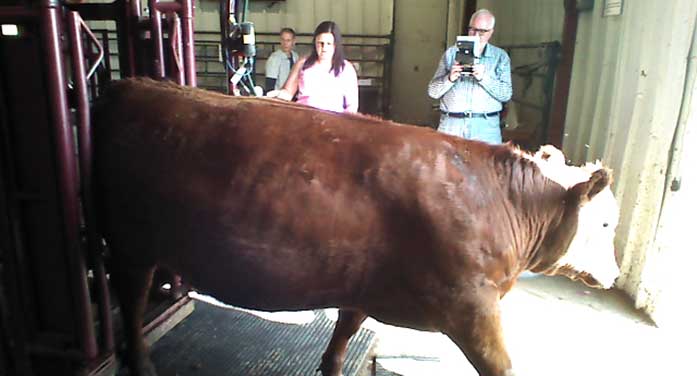New University of Alberta research is mixing artificial intelligence with agriculture to help cattle ranchers.
An analytic “armchair rancher” mobile app is being developed to help beef producers better manage various aspects of their herds. The smart device application will aid them – by leveraging the masses of data they already collect daily on factors like herd genetics, feedlots and economics – in making the most informed business decisions they can.
“The app is really being designed to act as an assistant to ranchers,” said Professor David Wishart, a researcher in the U of A’s Faculty of Science and Faculty of Medicine & Dentistry.
Wishart is collaborating with a team led by Graham Plastow, a professor in the Faculty of Agricultural, Life & Environmental Sciences. The three-year project is supported by a $481,000 grant from Alberta Innovates.
The app could help identify trends in everything from the weather to beef prices, Wishart said.
“As business owners, their profit depends on decisions about the stock market, cost of feed and other factors, and rather than having to do it just by feel, we want to give them a digital assistant that helps them make smart moves.”
Alberta’s data-rich cattle industry lends itself naturally to the development of an app, Wishart noted.
“For artificial intelligence to work, a lot of data is needed, and while many areas in agriculture are not very digitized, there’s an enormous number and types of measurements for cattle, so there’s this huge potential for getting the data needed to make machine learning work.”
The app will help ranchers create scenarios to predict risk and potentially cut losses in their operations. It’s a function that would have been useful for the drought they experienced this summer, Wishart suggested.
“Ideally, if we had the app developed now, it would have told beef producers in April that this summer would be a dry year. It means they could have taken measures like trapping more water in dugouts, buying feed earlier while prices were lower or downsizing their herds. The app would allow them to do that modelling.”

Researcher Graham Plastow, who is leading the team developing the armchair rancher app, uses a device to scan an animal to predict its weight using machine learning and compare it with the animal’s actual weight measured in the chute. (Photo: Supplied)
Based on available historical data, the researchers plan to program the app to help predict future trends. For example, weather patterns from the past 40 years are accessible, making it possible for farmers to type in their postal codes and estimate what the weather could be like in their regions, one month to several years from now.
They also want the app to include market projections, based on how events like drought in other parts of the world could affect factors like North American feed or cattle prices.
“We want to be able to allow this app to send a warning about an event such as feed prices collapsing, so farmers can make their business decisions accordingly,” Wishart said.
The app will also improve as ranchers contribute their data, said Plastow.
“As everyone contributes their information, the data deepens. The more data they contribute, the more valuable the overall armchair app becomes. They’ll have the benefit of both visualizing their information and melding it with general information to come up with a solution that works for their scenario.”
The researchers are actively discussing the app’s development with ranchers to capture what they need; a prototype will be tested next year.
“They’re already helping us understand what questions and answers will be useful,” Plastow noted.
Once developed, the app could also be useful to other agricultural, construction and forestry industries.
“Because we’re tracking market data, the same economic predictive tools we need for ranchers could apply to just about any other field,” said Wishart, who expects the app to eventually be picked up in the marketplace as precision farming moves forward.
The data being mined and mapped to develop the app will also benefit other academics and government agencies, he added.
“We’ve created a really useful resource of geospatial data about soil, climate, weather and financial information that is now viewable and accessible.”
The research is supported through Alberta Innovates under the agency’s Smart Agriculture and Food Digitization and Automation Challenge Program and by Beefbooster.
| By Bev Betkowski
This article was submitted by the University of Alberta’s Folio online magazine. The University of Alberta is a Troy Media Editorial Content Provider Partner.
© Troy Media
Troy Media is an editorial content provider to media outlets and its own hosted community news outlets across Canada.


